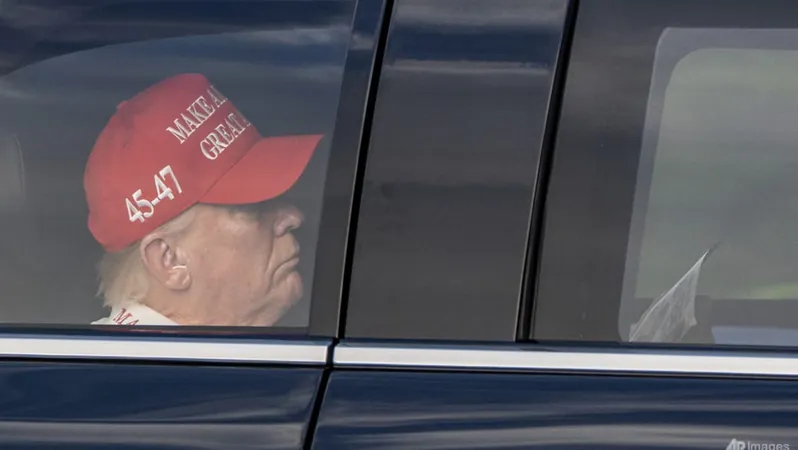
Brace for Impact: Trump Stands Firm on Tariffs, Promises Economic Revolution!
2025-04-05
Author: Wei Ling
In a bold statement made on Saturday, April 5, US President Donald Trump reaffirmed his commitment to extensive tariffs imposed on nations worldwide, cautioning Americans to brace for potential hardships ahead yet assuring them of unprecedented investments and future prosperity.
With the introduction of these tariffs, which began just after midnight, the Trump administration signaled a new era of economic policy designed to rectify trade imbalances. “We have been the dumb and helpless ‘whipping post’, but not anymore. We are bringing back jobs and businesses like never before,” Trump declared via his Truth Social platform. He described the tariff initiative as an “economic revolution,” challenging his critics by stating, “Hang tough, it won't be easy, but the end result will be historic.”
The US has implemented a 10% "baseline" tariff affecting most imports, with notable exceptions for goods from Mexico and Canada. This decision came under emergency economic powers aimed at tackling trade deficits, which the White House claims are a result of unfair trade practices and excessive value-added taxes from trading partners.
By April 9, approximately 60 trading partners—including major economies like the European Union, Japan, and China—will face heightened tariffs tailored specifically to their economies. A striking 34% tariff on Chinese imports set to launch next week has already prompted Beijing to retaliate with comparable tariffs on US goods starting April 10. The Chinese government has also announced intentions to escalate the dispute by challenging the US at the World Trade Organization (WTO) and placing restrictions on the export of rare earth elements critical for high-tech manufacturing.
Trump asserted, “China has been hit much harder than the USA, not even close,” emphasizing that many nations have taken advantage of the US trade system for years. Despite his confrontational stance, several countries remain cautious while assessing the growing trade tensions amid concerns of a global recession.
Market Reactions and Economic Consequences
In light of these developments, global markets reacted sharply, with Wall Street witnessing significant declines, mirroring drops across Asia and Europe. Expert economists have cautioned that these tariffs might stifle economic growth and spur inflation rates, creating a challenging financial landscape.
It’s crucial to note that Trump’s tariffs contain specific exclusions, such as the 25% tariffs imposed on steel, aluminum, and automobiles, which will not be compounded. Additionally, certain industries, including pharmaceuticals, semiconductors, and critical minerals, have so far been spared from this round of tariffs. However, investigations into these sectors may lead to further duties, indicating that reprieves could be temporary.
Despite Mexico and Canada’s exemption from these new tariffs, both countries currently face separate tariffs of up to 25% due to ongoing negotiations surrounding trade agreements.
Retaliation Looms
While Trump's gradual approach offers countries some room for negotiation, experts predict that if a reprieve isn’t granted, retaliation is likely, as evidenced by China’s swift response. EU Commissioner Maros Sefcovic stated that the bloc, facing a 20% tariff, will respond “in a calm, carefully phased, unified way,” while signaling their intention to remain active in the negotiations.
France and Germany have proposed potential retaliatory measures, including a tax on American technology firms, indicating a serious international backlash against Trump’s trade policies. Japan's leadership has called for measured responses in light of the 24% tariffs on Japanese goods introduced by the US.
In other news, Trump emphasized the importance of collaboration with international partners, mentioning productive discussions with Vietnam’s leadership amidst extraordinary 46% duties levied on imports from the country.
These latest tariff measures, marking the most significant increase in tariffs since the Smoot-Hawley Tariff Act of 1930—which initiated an era of global trade conflict—could lead to a staggering effective US tariff rate of 24%, surpassing levels not seen since the Great Depression. The ramifications of such aggressive economic policies will likely resonate throughout the global economy for the foreseeable future. Hold onto your hats—this is just the beginning of an unfolding economic saga!


 Brasil (PT)
Brasil (PT)
 Canada (EN)
Canada (EN)
 Chile (ES)
Chile (ES)
 Česko (CS)
Česko (CS)
 대한민국 (KO)
대한민국 (KO)
 España (ES)
España (ES)
 France (FR)
France (FR)
 Hong Kong (EN)
Hong Kong (EN)
 Italia (IT)
Italia (IT)
 日本 (JA)
日本 (JA)
 Magyarország (HU)
Magyarország (HU)
 Norge (NO)
Norge (NO)
 Polska (PL)
Polska (PL)
 Schweiz (DE)
Schweiz (DE)
 Singapore (EN)
Singapore (EN)
 Sverige (SV)
Sverige (SV)
 Suomi (FI)
Suomi (FI)
 Türkiye (TR)
Türkiye (TR)
 الإمارات العربية المتحدة (AR)
الإمارات العربية المتحدة (AR)